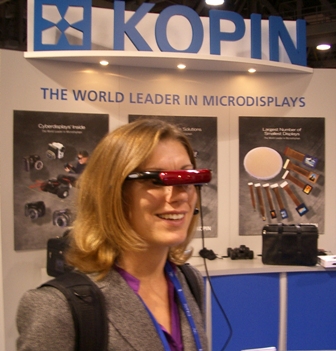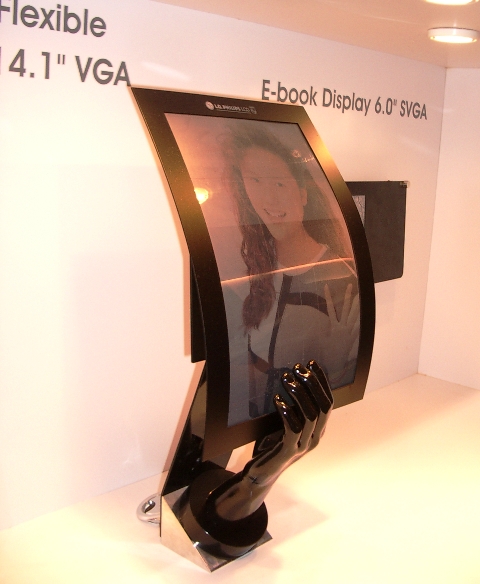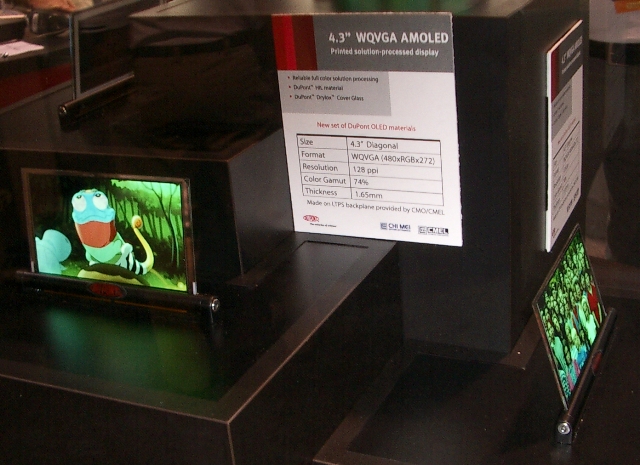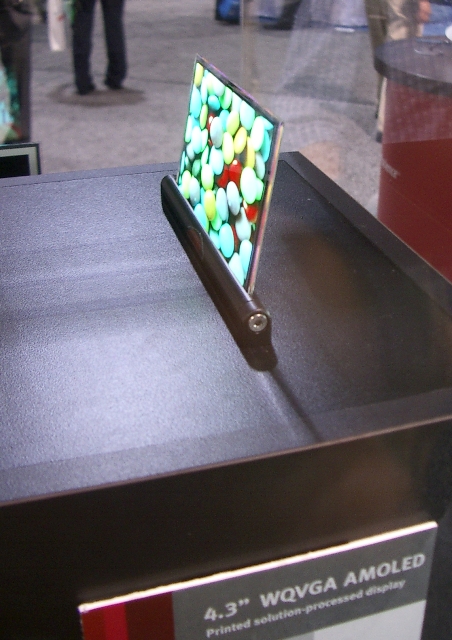
Video glasses may become ubiquitous
This is one of my favorite shows. The display industry has come a tremendous way since the first days of electromechanical TV at the turn of the last century. This year’s show had technologies from iridescent reflective to a resurrected field-emissive screen. The OLED and its manufacture (Dupont had a major presence for its phosphor, OLED, and other display materials) as well as electronic paper were the buzz, and promise to actually become available to consumers in real quantities this coming year.
LG Philips also had 14.1- and 6-in. flexible electronic paper displays. Color electronic paper is just on the threshold of being, but at the present time is only viable in monochrome.
Organic Light-Emitting Diode (OLED) technology was the real hot ticket. Now poised to enter the market, OLED’s color, brightness, and thinness make it the hot new tech for next-generation PDA, media, and smart phone apps. The relatively short lifetime of OLEDs (in small screen sizes, ~3 years) aren’t an issue in a category that turns every 18 months.
LCDs were of course everywhere, and every company had at least one screen backlit by RGB LEDs. The increased lifetime, ruggedness, and color gamut of LEDs are well worth the increased cost, which will continue to go down as time passes.
Displays weren’t the only thing at the display show. There were a lot of infrastructure companies, especially touchscreen manufacturers. One company, Infinitouch, had a force-sensor-based system that could function with holes in the substrate and with different materials applied. Very impressive.
An interesting development was the absence of two technologies, inorganic electroluminescent and SED, and the presence of an old tech thought obsolete, spindt-tip field-emissive display technology. With LCD, DLP, and Plasma so mature, it’s difficult to see how a new technology can take market share. But if you can reach a magic price point (cheaper than everybody else) or deliver performance even a casual observer can appreciate, you still have a chance.





















Disappearance of SED is no surprise. The Japanese spent more time and energy on carving up the pie than bringing the technology to market in time to compete.
Now, it’s too late to be anything other than too expensive.
“Video glasses may become ubiquitous”
Actually, Alix, that sort of cautious qualification is certainly prudent at times, but not in this case – that they will soon become ubiquitous is utterly inevitable and unavoidable. The only real question is “how soon?”
#2, Lauren, and how much? I want them now with full 3D effects!
Word on the street is, there’s some kinda inverse correlation between t, ‘how soon’ and $, ‘how much’ …
3D? Well, being someone who came up with the currently fashionable 3D method some 20 years ago, I can tell you that homebrewing a pair is not a biggie – but getting your hands on the media might be trickier. And maybe not – I haven’t looked, there may be a ton of media already out there, ready for download – maybe even courtesy of the developers.
I just wish I had gone the patent route – but then again, it’s hardly the first time the ship has sailed without me…
#4, Lauren, are you talking about 90 degree polarization or 15-30 fps blanking of L/R lenses? Just curious.
Actually 60fps L/R LCD shutters, yes, synched to alternating video fields. I dreamt this up in the mid-80s, never did anything with it, figured that someone better-financed would beat me to it anyway, since it was so obvious… Had I known it would take everyone else this long to get around to it, I would’ve put some effort behind it. Oh, well…
#6, Lauren, wow, 60 fps. That would be more than sufficient, since the persistence of vision is good down to, what, about 16 fps? I had thought about oppositely polarized interspersed frames so all the equipment is in the projection / display, but tech today could certainly support inexpensive computerized glasses to achieve the same effect. Either way, I still would like the tech to be available now so I can watch Darth Vader’s light saber come right out of the screen.
2,
Well, since you put me on the spot I’ll go on the record:
a) Video glasses will become common. The latest devices are cheap, and will be where 3D video actually takes hold. Direct-view 3D using parallax separation will never evade the eye-fatigue issue.
b) RGB-LED driven light engines will eventually dominate rear-projection and LCD TVs.
c) Compact flourescent lights are a premature solution (if only because they contain mercury) and should be avoided. Solid-state lighting is just around the corner.
d) We have just begun to get the most out of LCD technology.
e) OLED displays will dominate handheld display applications.
f) SED, Iridescent, electrowetting, and inorganic EL are dead in the water unless they produce a magic product before the end of next year.
g) However, inorganic El will be a bigger player in solid-state lighting (monochrome is easy) than OLED if only because most of the tech is in the public domain.
h) None of the next-generation display technologies will get anywhere unless they demonstrate a clear advantage like OLED (color gamut and lambertian emission) because they all need an active electronic backplane to control the pixels fast and accurately enough to produce the kind of video we’re accustomed to seeing. Since that creates a fixed-price start point, all of the next(?)-generation techs are lost until they can provide the base performance a consumer expects. Off the top of my head, of thevarious and sundry techniques fighting for a space on your living-room wall, there is bi-stable iridescent, e-ink, electrowetting, and cholesteric LCD, the seemingly dead nanotube-based FED, the resurrected spindt-tip-based field-emissive display, SED (if it ever happens) inorganic EL, and even a PH-based electro-stimulated bi-color ink technology 3M once showed me.
I) On a related note, nobody would buy the fuzzy-ass hologram emitters in Star Wars.
J) Did I already say that solid-state lighting would change the world? If I were the dude in “The Graduate” I’d say, “solid-state lighting”.
6,
The short-lived Vectrex video system had 3-D glasses of the interruptor type. A slotted disk spun in the glasses, alternately blocking the eyes in synch with the alternating images on the screen. A little buggy on the eyes after a while, but it made their flavor of Asteroids quite interesting.
#8, Alix, that picture (and her “glasses”) reminds me of a Star Trek – The Next Generation episode titled “The Game” (qv.)
From an episode summary:
She introduces to him a “game”, involving a device that fits over the ears, which projects into the eyes an image of discs going into tubes. When the disc goes into the tube, the player is “rewarded” by receiving pleasure signals from the device.
Next up: pr0n on the commuter ride / flight?
Smartalix said, “RGB-LED driven light engines will eventually dominate rear-projection and LCD TVs.”
I saw a Samsung 61″ DLP HD TV yesterday with LED light source (instead of bulb) and it looked really good. Very nice for the light source to last the life of the TV.
#10, Alix, sounds great. Wish I could afford to replace my projector with LED, those bulbs are about $100 a pop and last maybe 2 years. But DLP is great, wouldn’t go any other way.
10,
An LED-driven display can acheive over 115% of the NTSC color gamut spec.
#7 – BR
“Lauren, wow, 60 fps. That would be more than sufficient, since the persistence of vision is good down to, what, about 16 fps? ”
Well, retinal latency – toward the center, mind you; the field does not respond linearly in respect to motion, color or a few other things – is 15-18Hz in the gen pop; however, when you’re blanking each eye alternately, that 30Hz is cut in half. No good. So 2X is actually the minimum you’d want. Even then I felt that that rate should be just a starting point.
Even 24Hz film projection uses shutters to raise the rate to 96Hz, you know. Actually, as I recollect, a major reason I didn’t pursue this was that LCDs at that time weren’t nearly fast enough.
A few years back (3? 7?) I read of some chappies that had been experimenting with high-speed film, i.e. pure 60fps shooting and projection – 2.5X, not 24fps oversampled to 96 – and as I recall, viewers reported a literally shocking increase in subjectively perceived ‘realism’ and no motion artifacts of any kind.